Research on Identification, Evaluation, and Digitization of Historical Buildings Based on Deep Learning Algorithms: A Case Study of Quanzhou World Cultural Heritage Site
Abstract
1. Introduction
- Since the reform and opening up in 1978, China’s urbanization has developed rapidly, and many villagers in Qiaonan Village have moved to towns for employment or settlement. A large number of new residential buildings have been constructed in the village, disconnecting it from its traditional architectural culture [3,4,5]. The phenomenon of “empty nesting” of historical buildings is serious, causing some historical buildings to fall into disrepair, suffer elevation damage, or even become dangerous. Some historical buildings are used as chicken or duck houses, which is highly detrimental to their preservation [3,4,5].
- Qiaonan Village has a long history and rich culture. However, over time, due to natural changes and the lack of systematic planning and management, the village’s current layout has become chaotic, with new and historical buildings intermingled. This disorganized arrangement hinders the protection and unified management of historical buildings [3].
- The absence of a building dataset necessitates the collection of information on village structures. However, because the buildings are closely spaced and the village paths are winding and narrow, it is difficult to scan building elevations effectively. This also poses potential fire safety risks.
- Identifying and evaluating historical buildings in Qiaonan Village, establishing a database to address the lack of digitized research on Quanzhou’s historical buildings.
- Combining YOLOv11’s object detection and GIS for categorizing and archiving Qiaonan Village buildings, replacing traditional methods with a more advanced, economical, and efficient process [40].
- Developing a technical route for building an intelligent monitoring platform based on deep learning and GIS for the hierarchical protection of historic buildings.
2. Methods and Data
2.1. Study Area
2.2. Multi-Model Comparison for Intelligent Classification of Historic Buildings
- Phase 1: Acquiring building elevation images of known ages in Qiaonan Village using cameras and smartphones. Images are annotated using LabelImg to build a labeled dataset.
- Phase 2: Training multiple models (CNN, Fast R-CNN, YOLOv8, and YOLOv11) and comparing their performances in building classification tasks to select the optimal model. Model robustness is validated under complex scene conditions.
- Phase 3: Integrating classification results into a GIS platform to generate a building distribution map based on geographic coordinates. Historical buildings are further scanned to create 3D point cloud models, where 2D photos, 3D models, and chronological labels are linked to their real-world locations. An intelligent management platform is built to support the hierarchical protection of historical buildings.
2.3. Historic Building Facade Data Collection
2.3.1. Elevation Data Set Construction
2.3.2. Elevation Data Set Segmentation
2.4. Deep Learning Algorithm Model Network Structure
- C3K2 Module: This module replaces a single large convolutional kernel (e.g., C2f) with two smaller convolutional kernels, effectively reducing computational load and enhancing processing speed. This design improves the model’s sensitivity to fine-scale features commonly found in historic building elevations, such as windows, cornices, and decorative elements.
- SPPF (Spatial Pyramid Pooling—Fast): This module facilitates the fusion of large-scale contextual information with fine-grained details by applying multiple spatial pooling layers in parallel. It improves the model’s ability to detect both global and localized architectural features within a single image.
- C2PSA (Convolutional Coordinate-aware Position and Spatial Attention): The C2PSA module introduces a spatial attention mechanism that enables the model to dynamically emphasize important regions in an image. This selective focus enhances detection performance, especially in visually complex or partially occluded scenes, which are common in historic village environments.
2.5. Training Strategies and Parameters
3. Results
3.1. Comparison of Building Recognition Results Based on Deep Learning Algorithms
- mAP@0.5 (mean average precision at IoU = 0.5): Measures precision when intersection-over-union is ≥0.5; higher values indicate better detection accuracy.
- mAP@0.5:0.95: A more stringent metric averaged over IoU thresholds from 0.5 to 0.95 (at 0.05 intervals); indicates bounding box localization accuracy.
- GFLOPs (Giga floating point operations): Reflects the model’s computational demand during inference; higher GFLOPs imply higher hardware requirements and less real-time efficiency.
- Params (parameters): Total number of trainable parameters; a measure of model complexity.
3.2. Training Process and Model Convergence Analysis
3.3. Classification and Post-Processing of Unknown Building Dates
3.3.1. Method Flow and Parameter Setting
- Confidence threshold: 0.6 (predictions below this are discarded);
- Non-maximum suppression (NMS): IoU threshold of 0.5 to eliminate redundant detections;
- Output categories: QD (0), RC (1), PRC (2), matching training label encoding.
3.3.2. Analysis of Classification Results
- Among the 178 unknown buildings, the model identified 15 architectural heritage buildings, including 12 QD buildings and 3 RC buildings, with an average confidence level of 0.90, which indicates that the model has a strong ability to recognize architectural heritage features. The architectural heritage is mainly distributed in the core area of the village, which is highly consistent with the positioning of the “Ming and Qing Dynasty Ancient Village” recorded in the local history (see Figure 6).
- The percentage of PRC building architecture reached 91.6%, which was the highest, and was concentrated in the periphery of the village, reflecting the spatial expansion pattern in the process of urbanization. The average confidence level was 0.90, which verifies that the model accurately recognized the characteristics of PRC buildings (e.g., flat roofs, tiled elevations).
3.4. GIS Annotation and Visualisation of Historic Buildings
- The 15 newly identified heritage buildings were combined with the 13 known ones, totaling 28 historical buildings.
- Laser scanning was conducted to generate 3D point cloud models of these structures.
- Spatial coordinates, 2D imagery, and 3D model data were integrated into GIS to create an interactive building distribution map.
4. Discussion
4.1. Research Results and Contributions
- The recognition of building elevations by deep learning algorithms confirms the feasibility of applying AI technology to the value assessment of historic buildings, improves the efficiency of identifying and categorizing historic buildings, and makes the protection system of historic buildings in Quanzhou more complete.
- Integrating the information, 2D pictures, and 3D models of the buildings to build a database of historical buildings with temporal and spatial attributes realizes the archiving of full-dimensional information and intelligent monitoring of historical buildings, which is an application and innovation for the protection and management of historical buildings. At the same time, the establishment of the database can promote the development of tourism in the heritage area, make tourists feel the local culture more intuitively, and realize the transformation and upgrading from sightseeing tourism to an in-depth cultural experience.
- Applying artificial intelligence technology to the study of identification, assessment, and digital management of historical buildings in Qiaonan Village will help the future protection of Quanzhou World Cultural Heritage Site and the construction of an intelligent monitoring system, promote the cross-fertilization of multiple disciplines in the field of historical building protection, and help build an intelligent historical building database and management platform.
4.2. Limitations of the Study
- The geographic locations of historical buildings need to be manually labeled in GIS, and 2D images and 3D models need to be converted into links to be inserted into the corresponding distribution points of historical buildings, which significantly increases the cost of data preprocessing and reduces the efficiency of data fusion.
- The building elevation of traditional villages under autonomous construction generates various complex problems. Confusing building layouts and narrow building spacing hinder the collection of building elevation information, and the identification process confuses the identification of some building elevations due to materials, building forms, and damaged building elevations, which is a problem that cannot be fully covered by the current data set.
- Although our research methodology has shown satisfactory results in the digitization of historic buildings in Qiaonan Village, the current study still focuses on selected villages in southern Fujian and lacks data on other historic building preservation zones and historic buildings in China, which does not adequately represent the public and historical value of historic buildings.
5. Conclusions
- Toward an Integrated Research Model: This study marks an initial advancement in the digital preservation of historical buildings. Future work will focus on enhancing the interoperability of deep learning algorithms with GIS and other spatial technologies, aiming to establish a “data collection–intelligent recognition–data integration” workflow. This model would support real-time monitoring and intelligent management, addressing the limitations of traditional preservation methods. We envision this framework serving as a blueprint for the intelligent protection of cultural heritage both in China and globally.
- Building a Smart Cultural Heritage Platform: The construction of an intelligent management system will not only assist in the preservation of the Quanzhou World Heritage Site but also enable dynamic assessments of tourism carrying capacity. This integration supports a balanced approach to cultural tourism development and heritage conservation, facilitating a transformation from passive sightseeing to active cultural engagement.
- Expanding Scope and Generalizability: The YOLOv11L-based detection system has proven effective in autonomously identifying and evaluating traditional village architecture, significantly reducing manual labor and increasing efficiency. In the next stage, the research will be expanded to include adjacent regions and broader national contexts, thereby strengthening the digital foundation of China’s historical building protection network and contributing to its systematic, intelligent evolution.
Author Contributions
Funding
Data Availability Statement
Acknowledgments
Conflicts of Interest
Abbreviations
| YOLO | You Only Look Once (deep convolutional neural network) |
| QD | Qing Dynasty |
| PRC | People’s Republic of China |
| RC | Republic of China |
| GIS | Geographic Information System |
| CTSs | Chinese traditional settlements |
| CNN | Convolutional neural network |
| R-CNN | Region-based convolutional neural network |
| CViT | Convolutional vision transformer |
| AI | Artificial intelligence |
| QGIS | Quantum Geographic Information System (cross-platform free and open-source desktop GIS application |
| PSP | Panoramic spherical photogrammetry |
| BIM | Building Information Modeling |
| 2D | Two-dimensional |
| 3D | Three-dimensional |
| HSV | Hue, saturation, value |
| FPN | Feature pyramid networks |
| GFLOPs | Giga floating point operations per second |
| CSP | Cross Stage Partial |
| PANet | Path aggregation network |
| SPP | Spatial Pyramid Pooling |
| mAP | Mean average precision |
| Params | Parameters |
| cls_loss | Classification loss |
| NMS | Non-maximum suppression |
| IOU | Intersection over union |
| AHE_Dataset | Architectural heritage elements dataset |
References
- Wang, Q. Quanzhou: The World Emporium at the East End of the Maritime Silk Routes. In Architecture, Monuments and Urbanism Along the Silk Roads; Shebahang, M., Ed.; UNESCO Publishing: Paris, France, 2024; pp. 31–53. [Google Scholar]
- Quanzhou Municipal People’s Government. Luoyang Bridge: “The First Bridge in the Sea” Born in the Trade Boom of the Song Dynasty. Available online: https://www.quanzhou.gov.cn/gastronomy/ch/qzgk/syzc/202502/t20250211_3138540.htm (accessed on 20 February 2025).
- Ren, Z. Study on the protection and renewal of the cultural landscape of Qiaonan Village in Quanzhou under the perspective of human-land relations. Beauty Times 2021, 10, 46–48. [Google Scholar] [CrossRef]
- Qiu, H.; Zhang, J.; Zhuo, L.; Xiao, Q.; Chen, Z.; Tian, H. Research on intelligent monitoring technology for roof damage of traditional Chinese residential buildings based on improved YOLOv8: Taking ancient villages in southern Fujian as an example. Herit. Sci. 2024, 12, 231. [Google Scholar] [CrossRef]
- Li, Y.; Jia, L.; Wu, W.; Yan, J.; Liu, Y. Urbanisation for rural sustainability—Rethinking China’s urbanisation strategy. J. Clean. Prod. 2018, 178, 580–586. [Google Scholar] [CrossRef]
- Voulodimos, A.; Doulamis, N.; Doulamis, A.; Protopapadakis, E. Deep learning for computer vision: A brief review. Comput. Intell. Neurosci. 2018, 2018, 7068349. [Google Scholar] [CrossRef]
- Ji, S.Y.; Jun, H.J. Deep learning model for form recognition and structural member classification of East Asian traditional buildings. Sustainability 2020, 12, 5292. [Google Scholar] [CrossRef]
- Han, Q.; Yin, C.; Deng, Y.; Liu, P. Towards classification of architectural styles of Chinese traditional settlements using deep learning: A dataset, a new framework, and its interpretability. Remote Sens. 2022, 14, 5250. [Google Scholar] [CrossRef]
- Siountri, K.; Anagnostopoulos, C.N. The classification of cultural heritage buildings in Athens using deep learning techniques. Heritage 2023, 6, 3673–3705. [Google Scholar] [CrossRef]
- Wei, G.; Wan, F.; Zhou, W.; Xu, C.; Ye, Z.; Liu, W.; Lei, G.; Xu, L. BFD-YOLO: A YOLOv7-based detection method for building elevations defects. Electronics 2023, 12, 3612. [Google Scholar] [CrossRef]
- Deng, J.; Xuan, X.; Wang, W.; Li, Z.; Yao, H.; Wang, Z. A Review of Research on Object Detection Based on Deep Learning. In Proceedings of the 2020 International Seminar on Artificial Intelligence, Networking and Information Technology, Shanghai, China, 18–20 September 2020. [Google Scholar] [CrossRef]
- Jiao, L.; Zhang, F.; Liu, F.; Yang, S.Y.; Li, L.L.; Feng, Z.X.; Qu, R. A survey of deep learning-based object detection. IEEE Access 2019, 7, 128837–128868. [Google Scholar] [CrossRef]
- Ultralytics. Ultralytics YOLO Documentation. Available online: https://docs.ultralytics.com/zh/models/yolo11/ (accessed on 20 February 2025).
- SkyCloud Developer Community. Computer Vision Frontier Exploration: In-depth Analysis of Target Detection and Recognition Algorithms. Available online: https://www.ctyun.cn/developer/article/637181884231749 (accessed on 20 February 2025).
- Khanam, R.; Hussain, M. Yolov11: An Overview of the Key Architectural Enhancements. arXiv 2024, arXiv:2410.17725. Available online: https://arxiv.org/abs/2410.17725 (accessed on 20 February 2025).
- Yu, L. Semantic Representation: From Color to Deep Embeddings. Ph.D. Thesis, Universitat Autònoma de Barcelona, Bellaterra, Spain, 2019. [Google Scholar]
- Obeso, A.M.; Benois-Pineau, J.; Acosta, Á.R.; Vázquez, M.S.G. Architectural style classification of Mexican historical buildings using deep convolutional neural networks and sparse features. J. Electron. Imaging 2017, 26, 011016. [Google Scholar] [CrossRef]
- Wu, S.; Di, B.; Ustin, S.L.; Stamatopoulos, C.A.; Li, J.; Zuo, Q.; Wu, X.; Ai, N. Classification and detection of dominant factors in geospatial patterns of traditional settlements in China. J. Geogr. Sci. 2022, 32, 873–891. [Google Scholar] [CrossRef]
- Li, M.H.; Yu, Y.; Wei, H.; Chan, T.O. Classification of the qilou (arcade building) using a robust image processing framework based on the Faster R-CNN with ResNet50. J. Asian Archit. Build. Eng. 2024, 23, 595–612. [Google Scholar] [CrossRef]
- Nordmark, N.; Ayenew, M. Window Detection in Elevations Imagery: A Deep Learning Approach Using Mask R-CNN. arXiv 2021, arXiv:2107.10006. Available online: https://arxiv.org/abs/2107.10006 (accessed on 20 February 2025).
- Llamas, J.; Lerones, P.M.; Medina, R.; Zalama, E.; Gómez-García-Bermejo, J. Classification of architectural heritage images using deep learning techniques. Appl. Sci. 2017, 7, 992. [Google Scholar] [CrossRef]
- Liu, J. Research on Building Style Recognition Based on Deep Learning. Master’s Thesis, Xi’an University of Architecture and Technology, Xi’an, China, 2023. Available online: https://link.cnki.net/doi/10.27393/d.cnki.gxazu.2023.000478 (accessed on 20 February 2025).
- Gao, C.; Zhang, Q.; Tan, Z.; Zhao, G.; Gao, S.; Kim, E.; Shen, T. Applying optimized YOLOv8 for heritage conservation: Enhanced object detection in Jiangnan traditional private gardens. Herit. Sci. 2024, 12, 31. [Google Scholar] [CrossRef]
- De Amorim, A.L.; Fangi, G.; Malinverni, E.S. Documenting Architectural Heritage in Bahia, Brazil, Using Spherical Photogrammetry. In Proceedings of the 24th International CIPA Symposium, Strasbourg, France, 2–6 September 2013. [Google Scholar] [CrossRef]
- Tsilimantou, E.; Delegou, E.T.; Nikitakos, I.A.; Ioannidis, C.; Moropoulou, A. GIS and BIM as integrated digital environments for modeling and monitoring of historic buildings. Appl. Sci. 2020, 10, 1078. [Google Scholar] [CrossRef]
- Bolstad, P. GIS Fundamentals: A First Text on Geographic Information Systems, 6th ed.; XanEdu: Ann Arbor, MI, USA, 2019. [Google Scholar]
- Parlavecchia, M.; Pascuzzi, S.; Anifantis, A.S.; Santoro, F.; Ruggiero, G. Use of GIS to evaluate minor rural buildings distribution compared to the communication routes in a part of the Apulian territory (Southern Italy). Sustainability 2019, 11, 4700. [Google Scholar] [CrossRef]
- Duckham, M.; Sun, Q.C.; Worboys, M.F. GIS: A Computing Perspective, 3rd ed.; CRC Press: Boca Raton, FL, USA, 2023. [Google Scholar] [CrossRef]
- Petrescu, F. The Use of GIS Technology in Cultural Heritage. In Proceedings of the 21st International CIPA Symposium: Anticipating the Future of the Cultural Past, Athens, Greece, 1–6 October 2007; CIPA: Athens, Greece, 2007. [Google Scholar]
- Cerutti, E.; Noardo, F.; Spanò, A. Architectural Heritage Semantic Data Managing and Sharing in GIS. In Proceedings of the 1st International Conference on Geographical Information Systems Theory, Applications and Management, Barcelona, Spain, 28–30 April 2015. [Google Scholar] [CrossRef]
- Taboroff, J. Cultural Heritage and Natural Disasters: Incentives for Risk Management and Mitigation. In Managing Disaster Risk in Emerging Economies; Kreimer, A., Arnold, M., Eds.; World Bank: Washington, DC, USA, 2000; Volume 2, pp. 71–79. [Google Scholar]
- Fangi, G. Multiscale Multiresolution Spherical Photogrammetry with Long Focal Lenses for Architectural Surveys. In Proceedings of the ISPRS Mid-Term Symposium, Newcastle, UK, 8–11 June 2010; ISPRS: Newcastle, UK, 2010. [Google Scholar]
- Almeida, A.; Gonçalves, L.M.S.; Falcão, A.P.; Ildefonso, S. 3D-GIS Heritage City Model: Case Study of the Historical City of Leiria. In Proceedings of the 19th AGILE International Conference on Geographic Information Science, Helsinki, Finland, 14–17 June 2016. [Google Scholar]
- Braik, A.M.; Koliou, M. Automated building damage assessment and large-scale mapping by integrating satellite imagery, GIS, and deep learning. Comput.-Aided Civ. Infrastruct. Eng. 2024, 39, 2389–2404. [Google Scholar] [CrossRef]
- Shen, Y.; Zhu, S.; Yang, T.; Chen, C.; Pan, D.; Chen, J.; Xiao, L.; Du, Q. BDANet: Multiscale convolutional neural network with cross-directional attention for building damage assessment from satellite images. IEEE Trans. Geosci. Remote Sens. 2021, 60, 1–14. [Google Scholar] [CrossRef]
- Zhuo, L.; Zhang, J.; Hong, X. Cultural heritage characteristics and damage analysis based on multidimensional data fusion and HBIM—Taking the former residence of HSBC bank in Xiamen, China as an example. Herit. Sci. 2024, 12, 128. [Google Scholar] [CrossRef]
- Murphy, M.; McGovern, E.; Pavia, S. Historic Building Information Modelling (HBIM). Struct. Surv. 2009, 27, 311–327. [Google Scholar] [CrossRef]
- Dabrowski, P.S.; Zienkiewicz, M.H.; Tysiąc, P.; Burdziakowski, P.; Szulwic, J.; Sužiedelytė-Visockienė, J.; Paršeliūnas, E.; Obuchovski, R.; Bražiūnas, R.; Ossowski, R. HBIM Symmetry Parametrization Using TLS and UAV LiDAR Measurements. Measurement 2025, 253, 117750. [Google Scholar] [CrossRef]
- Tang, P.; Huber, D.; Akinci, B.; Lipman, R.; Lytle, A. Automatic Reconstruction of As-Built Building Information Models from Laser-Scanned Point Clouds: A Review of Related Techniques. Autom. Constr. 2010, 19, 829–843. [Google Scholar] [CrossRef]
- Fan, J.; Chen, Y.; Zheng, L. Artificial intelligence for routine heritage monitoring and sustainable planning of the conservation of historic districts: A case study on Fujian earthen houses (tulou). Buildings 2024, 14, 1915. [Google Scholar] [CrossRef]
- He, K.; Zhang, X.; Ren, S.; Sun, J. Deep Residual Learning for Image Recognition. In Proceedings of the IEEE Conference on Computer Vision and Pattern Recognition (CVPR 2016), Las Vegas, NV, USA, 26–28 June 2016. [Google Scholar] [CrossRef]
- Wang, Q.; Wu, B.; Zhu, P.; Li, P.; Zuo, W.; Hu, Q. ECA-Net: Efficient Channel Attention for Deep Convolutional Neural Networks. In Proceedings of the IEEE/CVF Conference on Computer Vision and Pattern Recognition (CVPR 2020), Seattle, WA, USA, 13–19 June 2020. [Google Scholar] [CrossRef]
- Tan, M.; Pang, R.; Le, Q.V. EfficientDet: Scalable and Efficient Object Detection. In Proceedings of the IEEE/CVF Conference on Computer Vision and Pattern Recognition (CVPR 2020), Seattle, WA, USA, 13–19 June 2020. [Google Scholar] [CrossRef]
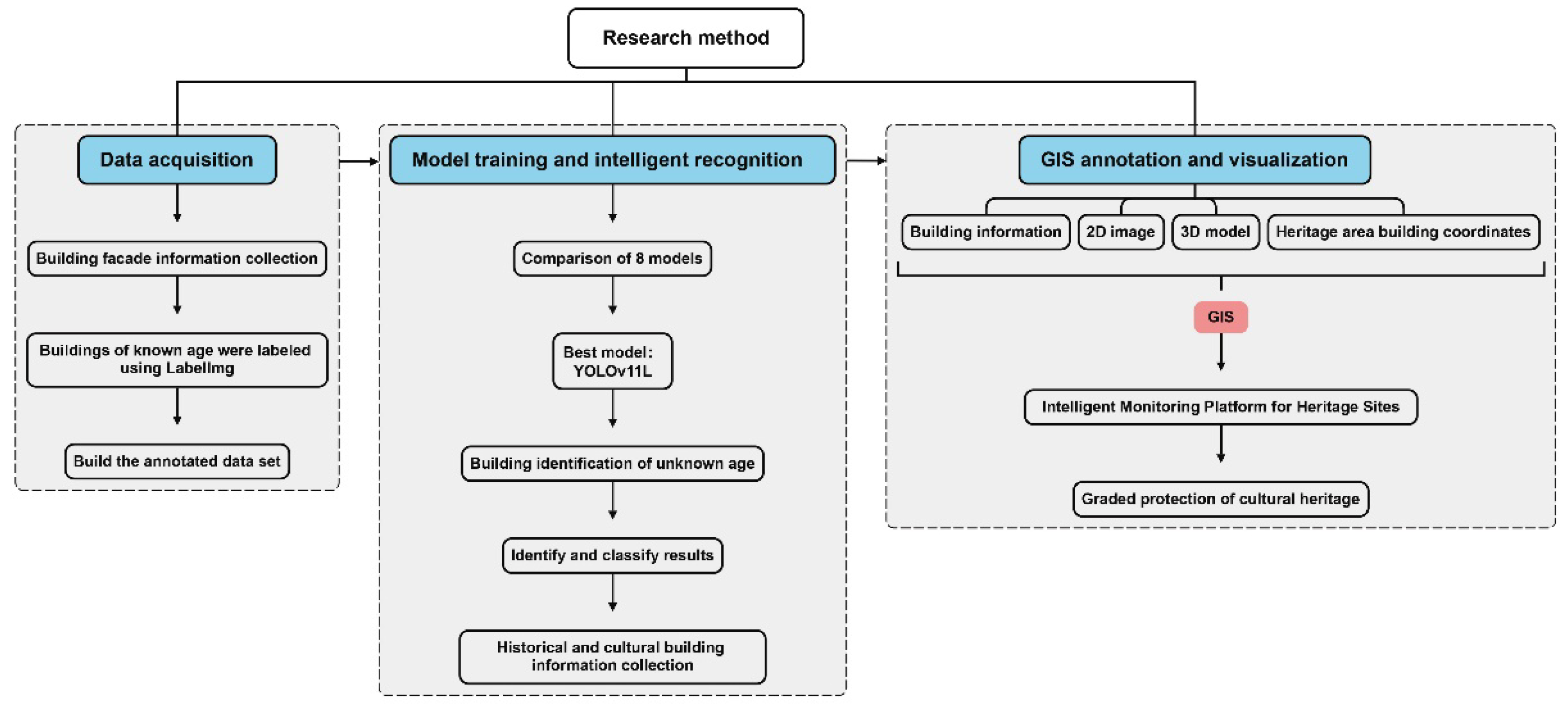

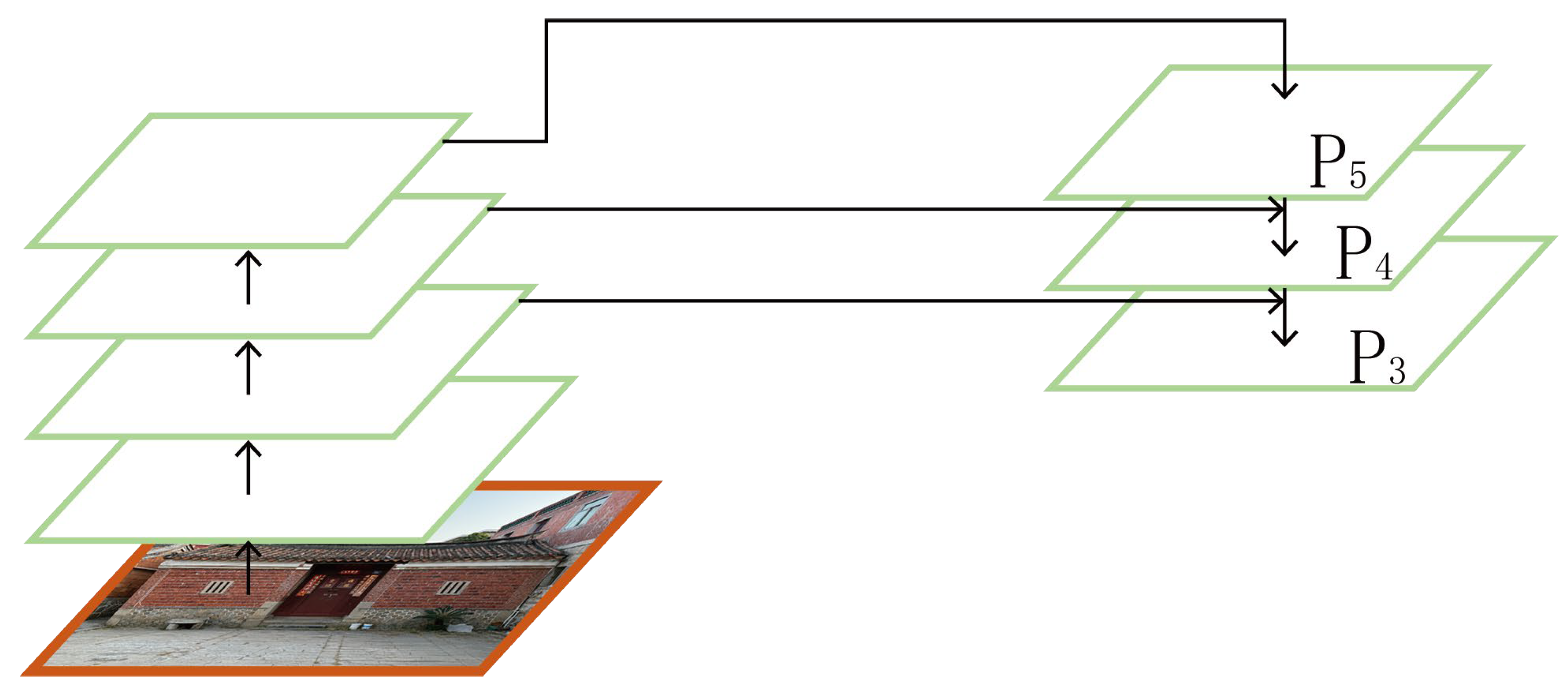
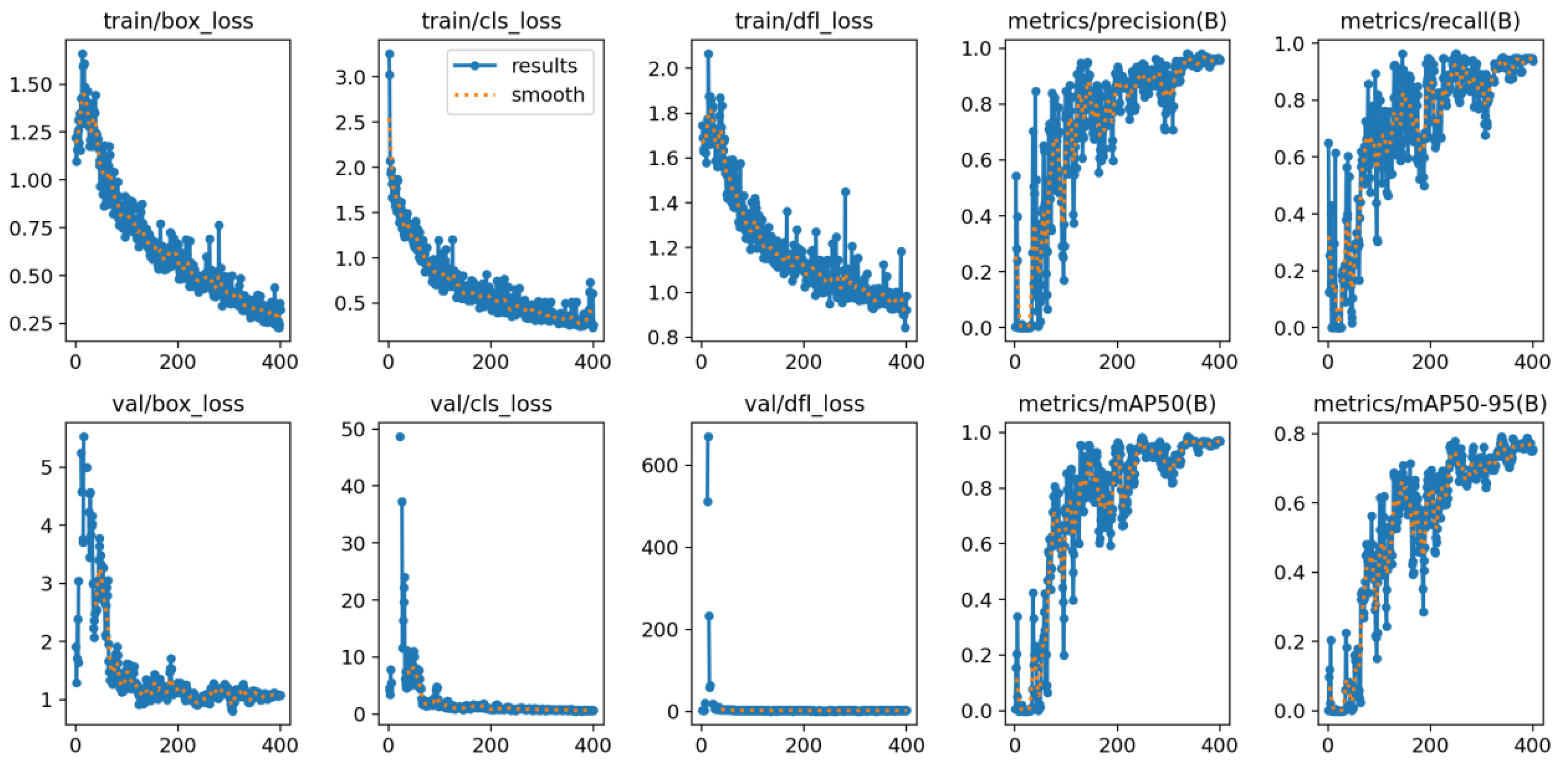
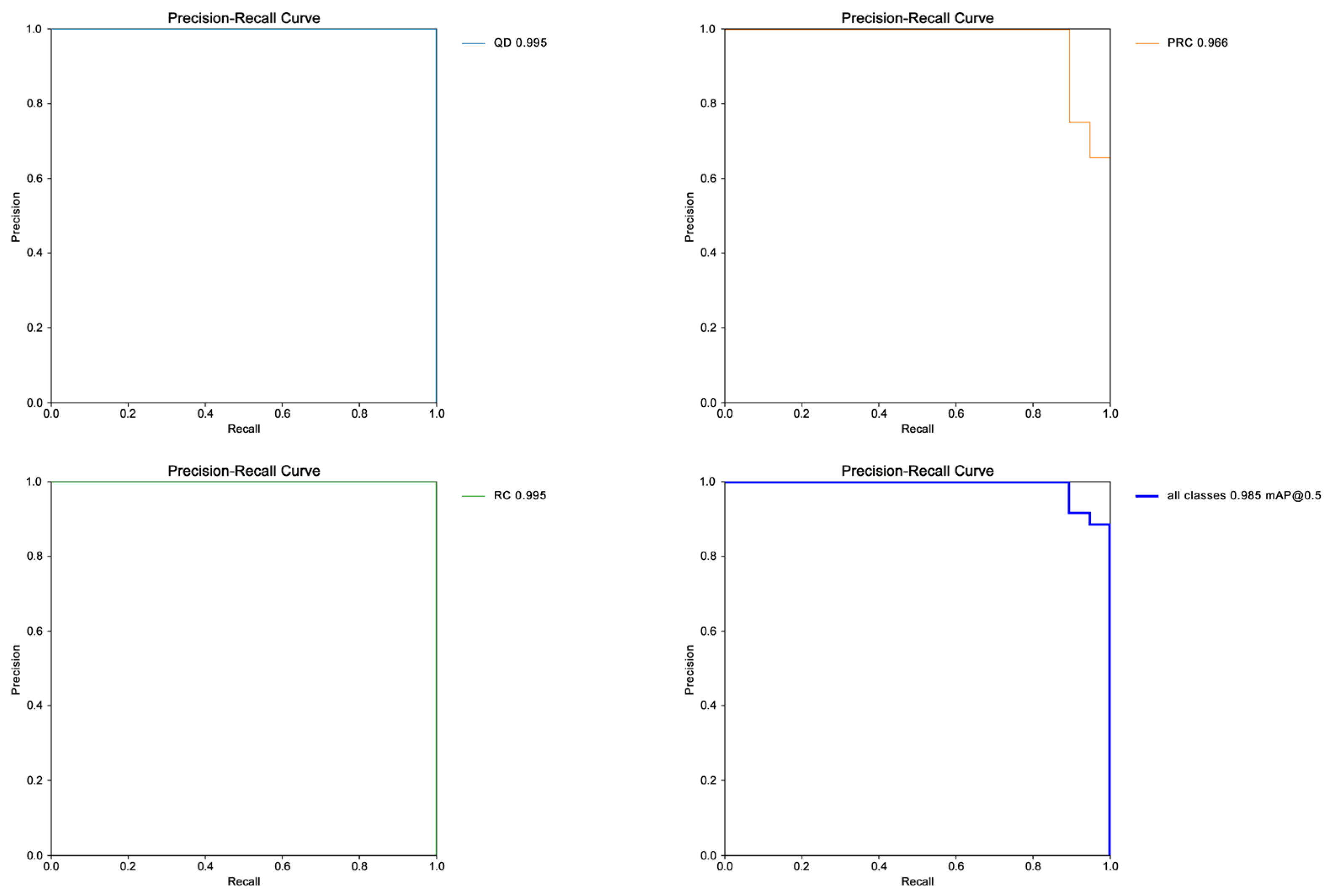
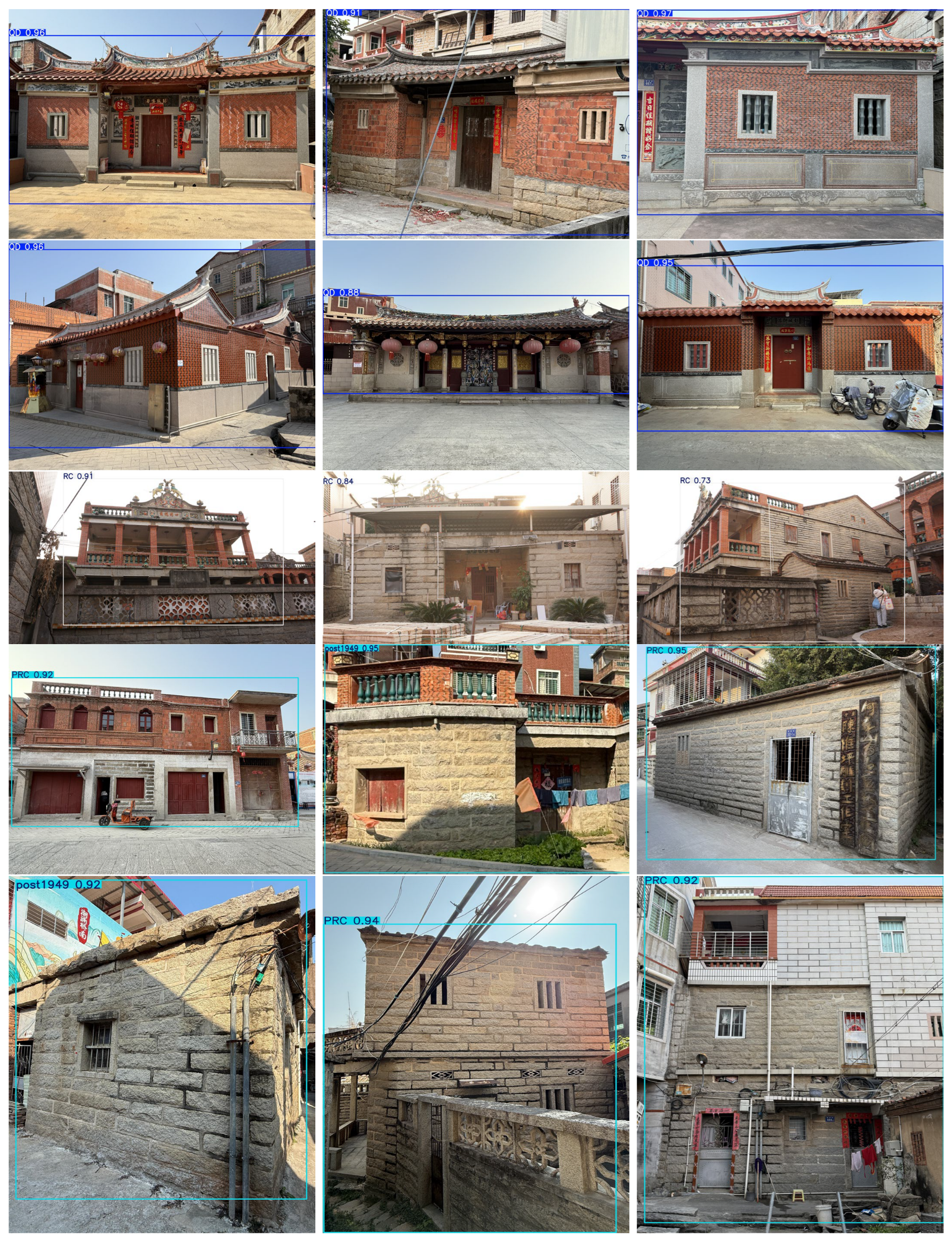


| Labels | Introduction | Representative Buildings |
|---|---|---|
| QD (1616–1912) | This is the oldest building type in the study area, preserving the style of local historical buildings, mainly Minnan ancient Gu-Cuo and ancestral temples and monasteries. | 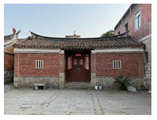 |
| RC (1912–1949) | Combining the historical buildings of Southern Fujian and Western architectural elements, it has formed a unique East-meets-West style and is an important material carrier of modern overseas Chinese culture. | 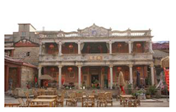 |
| PRC (post-1949) | Predominantly local self-built houses, with elevations made up mainly of modern building materials such as red bricks and ceramic tiles, some of which have been subsequently added to, resulting in the appearance of two styles in one building. |  |
| Model | Explanation |
|---|---|
| YOLOv11N | Lightweight version optimized for limited computing environments and real-time requirements. |
| YOLOv11S | Slightly enhanced capacity with low computational load. |
| YOLOv11M | Balanced trade-off between accuracy and efficiency. |
| YOLOv11L | Higher parameter count and deeper architecture for improved accuracy. |
| YOLOv11X | Deepest variant with maximum detection precision, ideal for offline analysis or high-performance servers. |
| Modeling | mAP50 | mAP50-95 | Parameters | GFLOPs | Accuracy (%) |
|---|---|---|---|---|---|
| Fast_RCNN | 0.6295 | 0.3297 | 41,304,286 | / | 63 |
| CNN | / | / | 51,480,000 | 0.57 | 89 |
| YOLOv8 | 0.529 | 0.261 | 3,006,233 | 8.1 | 52.9 |
| YOLOv11L | 0.985 | 0.792 | 23,281,625 | 86.6 | 98.5 |
| YOLOv11N | 0.978 | 0.807 | 2,582,737 | 6.3 | 97.8 |
| YOLOv11M | 0.988 | 0.755 | 20,032,345 | 67.7 | 98.8 |
| YOLOv11S | 0.941 | 0.807 | 9,413,961 | 21.3 | 94.1 |
| YOLOv11X | 0.929 | 0.756 | 56,830,489 | 194.4 | 92.9 |
| Age | Number (Buildings) | Average Confidence Level (Math.) |
|---|---|---|
| QD (0) | 12 | 0.92 |
| RC (1) | 3 | 0.87 |
| PRC (2) | 163 | 0.90 |
Disclaimer/Publisher’s Note: The statements, opinions and data contained in all publications are solely those of the individual author(s) and contributor(s) and not of MDPI and/or the editor(s). MDPI and/or the editor(s) disclaim responsibility for any injury to people or property resulting from any ideas, methods, instructions or products referred to in the content. |
© 2025 by the authors. Licensee MDPI, Basel, Switzerland. This article is an open access article distributed under the terms and conditions of the Creative Commons Attribution (CC BY) license (https://creativecommons.org/licenses/by/4.0/).
Share and Cite
Wang, S.; Zhang, J.; Tun, A.N.; Sein, K. Research on Identification, Evaluation, and Digitization of Historical Buildings Based on Deep Learning Algorithms: A Case Study of Quanzhou World Cultural Heritage Site. Buildings 2025, 15, 1843. https://doi.org/10.3390/buildings15111843
Wang S, Zhang J, Tun AN, Sein K. Research on Identification, Evaluation, and Digitization of Historical Buildings Based on Deep Learning Algorithms: A Case Study of Quanzhou World Cultural Heritage Site. Buildings. 2025; 15(11):1843. https://doi.org/10.3390/buildings15111843
Chicago/Turabian StyleWang, Siqi, Jiahao Zhang, Aung Nyan Tun, and Kyi Sein. 2025. "Research on Identification, Evaluation, and Digitization of Historical Buildings Based on Deep Learning Algorithms: A Case Study of Quanzhou World Cultural Heritage Site" Buildings 15, no. 11: 1843. https://doi.org/10.3390/buildings15111843
APA StyleWang, S., Zhang, J., Tun, A. N., & Sein, K. (2025). Research on Identification, Evaluation, and Digitization of Historical Buildings Based on Deep Learning Algorithms: A Case Study of Quanzhou World Cultural Heritage Site. Buildings, 15(11), 1843. https://doi.org/10.3390/buildings15111843






